Flora and Fauna: Methods and Results
Vegetation: All out search method was carried out in all landscape elements of the region enlisting grass, sedges, herbs, climbers, lianas, shrubs and trees. Species were identified on the spot. Table 2 lists 187 species observed during the survey. Table 3 lists 81 species of wetlands plants in the region. Figure 6 depicts a few flower plants of the region.
Butterflies and Odonates: Different species of butterflies and dragon flies were recorded by all out search method in all landscape elements of the region. Table 4 lists 59 butterfly species from the region, of which two are endangered (Crimson Rose and Daniad Eggfly) and two are endemic (Malabar Raven and South Indian Blue Oak Leaf) to the Western Ghats. Eleven species of dragon and damselflies (odonates) were also recorded from the region (Table 5). Figure 7depicts a few odanates from the region.
Amphibians and Reptiles: Nocturnal searches were carried along streams and wetlands of the region for amphibians. Six species recorded are given in Table 6 and Figure 8. Among these, two are endemic to the Western ghats (Sylvirana aurantiaca and Philautus wynaadensis) and one endangered species (Philautus wynaadensis). Table 7 details three species of reptiles encountered during the study.
Birds and Mammals: Hour count method in the morning hours was followed for bird sampling. Samplings were carried out in wetlands, paddy fields, scrub jungles, sacred grooves and forests. 55 species observed during the study are listed in Table 8 and Figure 9 depicts a few bird species recorded from the region. Indian peafowl is a Schedule I bird species. Seven species of mammals listed in Table 9 is based on opportunistic survey and interaction with knowledgeable residents of the region. Among these mammals, Gaur is Schedule I animal.
The region is rich in biodiversity evident from the occurrence of flora and fauna species. This study records 187 species of plants, 59 butterflies, 11 odonates, 6 amphibians, 3 reptiles, 55 birds and 7 species of mammals in a short duration of two days and in a few selected localities. Also many of these taxa are protected under Wildlife Protection Act, 1972, amended 2006. Considering the ecological and biodiversity significance of the region we suggest the following
-
Carrying capacity of the district has to be assessed on priority before implementing any developmental projects in the erstwhile undivided Dakshina Kannada district as per the recommendations of the committee constituted by the Government of Karnataka in 1998 under the chairmanship of Prof. Madhav Gadgil. The planning authorities should adopt holistic approaches considering various components of the system than sectoral fragmented approaches.
-
The integrity of water quality is already impaired due to the effluent inflow from industries commissioned and functional in the region (such as MRPL). Polluter pays‘ principle as per “Water(Prevention and Control of Pollution) Cess Act, 1977 and the Water(Prevention and Control of Pollution) Cess (Amendment) Act, 2003” to be implemented on priority. Regulatory authorities need to shed complacency in addressing the activities polluting vital ecosystems.
-
Considering the biological richness and ecological sensitiveness of the Western Ghats, large scale developmental projects should not be planned in any part of the Western Ghats as it is likely to impair functional capabilities of the ecosystem namely hydrology, biodiversity and ecology.
-
The current study area is in the close proximity (<30 km) to the Western Ghats and setting up megascale industrial projects including power projects in the region will lead to large scale land cover changes, which in turn lead to loss of biological diversity, natural resources and ultimately impact humans.
-
Rabi, Kharrif and summer agriculture crops apart from perennial horticultural crops clearly demonstrate the fertility of the soil, coupled with availability of the water.
-
The region needs to be conserved on priority as per the Wildlife Protection Act, 1972 (amended 2006), due to the presence of many endangered, endemic, rare and threatened species listed (Tables 2-9) under Schedules I-IV of Wildlife Protection Act, 1972.
-
In the event of intense industrialization, pollutants will disperse and get transported to the regions with higher wind regimes, which will affect ecologically sensitive the Western Ghats. This will influence the climate regime and the district will face serious and severe water crisis resulting in prolonged drought in the region.
-
The EIA conducted for the region violates the September 14 2006 EIA notification of Government of India as applicable to Category A and B1 projects.
-
The EIA report lacks detailed field investigations covering all seasons, landscapes, waterscapes, cultural, socio-economic aspects. The report fails to highlight the ecological, biological and cultural importance of the region;
- Cultural, religious and traditional values of the region are very high with the presence of historical monuments and pilgrimage centres such as Kateel, Shibaruru, etc.
- Cumulative impacts of existing projects on temporal scale and also the impacts of the proposed projects has not been accounted.
- The pollution due to industrial activities on land, water and air will impair the ecosystem services of the Western Ghats.
- The methods followed to quantify above aspects is inadequate and a quantified data is far from the actual in the EIA report. In contrary, a brief inventory undertaken by us in the study area brings out the biological and ecological importance of the region. More systematic sampling and documentation of environmental and ecological parameters will certainly prove the significance of the region and the need for conservation.
Proposed developmental activities in the vicinity of the Western Ghats - ecologically sensitive biodiversity hotspot violates the due recognition given to wildlife and forests, in the constitution of India.
I. Section 10 of the Constitution (Forty–second Amendment) Act 1976, Article 48: 48 A Protection and improvement of environment and safeguarding of forests and wildlife – The State shall endeavour to protect and improve the environment and to safeguard the forests and wildlife of the country.
II. Section 11 of the Constitution (Forty–second Amendment) Act 1976, Article 51 A, Part V-A: 51 A Fundamental Duties – It shall be the duty of every citizen of India - (g) To protect and improve the natural environment including forests, lakes, rivers and wildlife, and to have compassion for living creatures. Primary goals of conservation of the ecosystems are to:
- meet the ecological requirements of biodiversity conservation, wildlife preservation and ecological goods and services (soil conservation, fertility management, maintenance of hydrology, disease and storm protection, culture, recreation, etc.);
- meet the subsistence requirement of the forest-fringe communities for fuelwood, fodder, small timber and non-wood forest products through a system that ensures prevention of further degradation of the well stocked areas and regeneration of the degraded areas; and
- meet the market requirements, including the needs of forest-based industries, through increased productivity of the existing forests and expansion of forest and tree cover by encouraging investments by all stakeholders, especially on private land holdings.
III. Forest policy 1998 -
- Maintenance of environmental stability through preservation and, where necessary, restoration of the ecological balance that has been adversely disturbed by serious depletion of the forests of the country.
- Conserving the natural heritage of the country by preserving the remaining natural forests with the vast variety of flora and fauna, which represent the remarkable biological diversity and genetic resources of the country.
- Checking soil erosion and denudation in the catchment areas of rivers, lakes, and reservoirs in the interest of soil and water conservation, for mitigating floods and droughts and for the retardation of siltation of reservoirs.
- Increasing the sustainability of the forest/tree cover in the country through massive afforestation and social forestry programmes, especially on all denuded, degraded and unproductive lands.
- Meeting the requirements of fuel wood, fodder, minor forest produce and small timber of the rural and tribal populations.
- Increasing the productivity of forests to meet essential national needs.
IV: Forest (Conservation) Act, 1980
To check indiscriminate diversion of forestland. Under this legislation, approval of the Central Government is required before any forestland (noted as such in Government records) is diverted for non-forestry purposes.
V. The Wild Life (Protection) Act, 1972
This Act provides the protection of wild animals, birds and plants and for matters connected therewith or ancillary or incidental thereto with a view to ensuring the ecological and environmental security of the country. The Act has 11 Chapters and 121 Sections and has categorized animals, birds, and plants in six Schedules. Schedule I lists endangered species of mammals, amphibians, reptiles, birds, crustaceans and insects. For the possession, transportation, translocation, etc., of these species permission from the Government of India is needed. Penalties for contravention of the Act for Schedule I species are very stringent. The Act provides for the setting of protected areas such as national parks, wildlife sanctuaries, conservation reserves and community reserves. It also has provisions for control of trade and taxidermy in wildlife and for the setting of wildlife advisory boards to advise Central and State Governments.
VI. The Biological Diversity Act, 2002
The Act has a reference to the United Nations Convention on Biological Diversity at Rio
de Janeiro in 1992, which reaffirmed the sovereign rights of the States over their biological resources. The Act provides for the conservation of biological diversity, sustainable use of its components and fair and equitable sharing of the benefits arising out of the use of biological resources, knowledge and for connected matters. Specific clause applicable to this region is:
- 16 (1) Restriction on activities related to access to biological resources: Biodiversity Authority shall take the steps to restrict or prohibit the request for access to biological resources for the following reasons; namely :-
- activities that will result in adverse environmental impact which may be difficult to control and mitigate;
- the request for access is for any endangered taxa, endemic and rare species;
- the request for access may likely to result in adverse effect on the livelihoods of the local people;
- the request for access may cause genetic erosion or affecting the ecosystem function
VI The Environment (Protection) Act, 1986
This Act provides for the protection and improvement of environment and for matters
connected therewith. India participated at the United Nations Conference on the Human
Environment held at Stockholm in June 1972 and decided to take appropriate steps for
the protection and improvement of environment and the prevention of hazards to human
life and health, other living creatures, plants and property.
VII The National Environmental Policy 2006
The principal Objectives of this policy are
- Conservation of Critical Environmental Resources (To protect and conserve critical ecological systems and resources, and invaluable natural and man-made heritage, which are essential for life support, livelihoods, economic growth, and a broad conception of human well-being);
- Intra-generational Equity: Livelihood Security for the Poor (To ensure equitable access to environmental resources and quality for all sections of society, and in particular, to ensure that poor communities, which are most dependent on environmental resources for their livelihoods, are assured secure access to these resources);
- Inter-generational Equity (To ensure judicious use of environmental resources to meet the needs and aspirations of the present and future generations);
- Integration of Environmental Concerns in Economic and Social Development (To integrate environmental concerns into policies, plans, programmes, and projects for economic and social development).
- Efficiency in Environmental Resource Use (To ensure efficient use of environmental resources in the sense of reduction in their use per unit of economic output, to minimize adverse environmental impacts);
- Environmental Governance (To apply the principles of good governance to the management and regulation of use of environmental resources):
District authorities and elected representatives should take cognizance of prevailing regulation as per the constitution of India and should strive for the conservation of ecologically fragile and sensitive global biodiversity hotspot – the Western Ghats. Taking sincere measures in this direction would be a befitting gift by our generation to the future generation. The governance of the region should encompass the principle of transparency, rationality, accountability, participation, and regulatory independence.
Table 2. Plant species recorded from selected localities
Abrus precatorius |
Caralia antegerima |
Euphorbia hirta |
Acacia auriculiformis |
Careya arborea |
Ficus asperima |
Acacia concinna |
Carissa carandas |
Ficus hispida |
Acacia mangium |
Caryota urens |
Ficus racemosa |
Acampe sp. |
Cassia alata |
Ficus religiosa |
Achyranthes aspera |
Cassia tora |
Flacourtia montana |
Adathoda vasica |
Casuarina equisetifolia |
Garcinia indica |
Ageratum conyzoides |
Chasalia curviflora |
Garcinia xanthochymus |
Aglaia eleginoides |
Chloris barbata |
Geissaspis cristata |
Alstonia scholaris |
Cinnamom malabaricum |
Gloriosa superba |
Alternanthera sessilis |
Clerodendron paniculatum |
Gliricidia maculata |
Anacardium occidentale |
Clerodendron viscosum |
Grewia microcosm |
Anamirta cocculus |
Colocasia esculentum |
Gymnostachium febrifugum |
Antidesma menasu |
Corchorus capsularis |
Hemidesmus indicus |
Aporosa lindleyana |
Costus speciosus |
Heteropogon contortus |
Aristida cetacea |
Chromolina odorata |
Hibiscus furcatus |
Artabotrys sp. |
Crotalaria juncea |
Holigarna arnottiana |
Artocarpus hirsutus |
Crotalaria labernifolia |
Hopea parviflora |
Artocarpus integrifolius |
Crotalaria leptostachya |
Hopea ponga |
Artocarpus lakoocha |
Crotalaria striata |
Hugonia mastax |
Atlantia racemosa |
Cryptolepis buchanani |
Hyptis suaveolens |
Aurundinella metzii |
Curculigo orchioides |
Ichnocarpus frutescens |
Arundinella purpurea |
Curcuma oligantha |
Ipomoea pentaphylla |
Bambusa arundinacea |
Cyclea peltata |
Ipomoea prescapre |
Borassus flabellifer |
Cyrtococcum oxyphyllum |
Ipomoea sp. |
Borreria hispida |
Cyrtococcum patens |
Ischaemum indicum |
Borreria stricta |
Dalbergia sympathetica |
Ixora brachiata |
Brachiaria milliformis |
Derris uliginosa |
Ixora coccinea |
Bridelia stipularis |
Desmodium triquetrum |
Justicia simplex |
Breynia rhamnoides |
Desmodium triflorum |
Lantana camara |
Bryophyllum pinnatum |
Diospyros embryopteris |
Leea indica |
Buchanania lanzan |
Dioscorea triphylla |
Leucas linifolia |
Caesalpinia mimosoides |
Duranta plumeri |
Ludwigia perennis |
Caesaria sp. |
Elephantopus scaber |
Macaranga peltata |
Calycopteris floribunda |
Ensettia superba |
Madhuca latifolia |
Calophyllum inophyllum |
Eragrostis unioloides |
Mammea suriga |
Canthium parviflora |
Eragrostis viscosa |
Mangifera indica |
Canthium sp. |
Ervatamia heyneana |
Merremia hastata |
Melastoma malabathricum |
Ricinus communis |
Terminalia bellirica |
Memecylon malabaricum |
Saccharum spontaneum |
Terminalia catappa |
Memecylon talbotii |
Santalum album |
Terminalia paniculata |
Memecylon umbellatum |
Sapium insigne |
Themeda tremula |
Michelia champaca |
Saraca asoka |
Toddalia asiatica |
Mimosa pudica |
Scleria lithosperma |
Tragia involucrate |
Mimusops elengi |
Sida acuta |
Triumfetta rhomboidea |
Naregamia alata |
Sida rhombifolia |
Tylophora asthmatica |
Ocimum canum |
Smilax zeylanica |
Urena sinuata |
Odina wodier |
Solanum torvum |
Uvaria narum |
Olea dioica |
Sophubia delphinifolia |
Vangueria spinosa |
Ophiorrhiza harrisiana |
Spilanthus acmella |
Vateria indica |
Oplismenus compositus |
Sphaeranthus americanus |
Vernonia cinerea |
Pandanus furcatus |
Spondias pinnata |
Vitex altissima |
Passiflora foetida |
Streblus asper |
Vitex negundo |
Pennisetum polystachyon |
Strychnos nuxvomica |
Wagatea spicata |
Phoenix sylvestre |
Symplocos racemosa |
Wattakaka volubilis |
Phyllanthus amarus |
Synedrella nodiflora |
Wrightia tinctoria |
Phyllanthus urinaria |
Syzygium caryophyllata |
Zanthoxylum ovalifolium |
Plumeria alba |
Syzygium cumini |
Zizyphus oenoplia |
Pothos scandens |
Tacca pinnatifida |
Zizyphus rugosa |
Psychotria flavida |
Tamarindus indica |
Zizyphus jujuba |
Randia dumetorum |
Tectona grandis |
Zornia diphylla |
Rauwolfia serpentina |
Urena lobata |
Zingiber zerumbett |
|
|
|
Table 3. Wetland plants of the region
Aeschenomene aspera |
Eleocharis retroflexa |
Microcarpaea minima |
Ageratum conizoides |
Eleocharis spiralis |
Murdannia nudiflora |
Alternantera sessilis |
Eragrostis unioloides |
Murdannia semiteres |
Ammannia baccifera |
Eriocaulon cinereum |
Nymphaea nouchali |
Arundinella leptochloa |
Eriocaulon cuspidatum |
Nymphoides hydrophylla |
Bergia capensis |
Eriocaulon richardianum |
Nymphoides indica |
Centella asiatica |
Eriocaulon sexangulare |
Nyphoides parviflora |
Colocasia esculenta |
Fimbristylis acuminata |
Oryza rufipogon |
Commelina diffusa |
Fimbristylis bisembellata |
Oryza sativa |
Corchorus capsularis |
Fimbristylis ferruginea |
Oryza sativa var.nivara |
Crinum viviparum |
Fimbristylis littoralis |
Pandanus fascicularis |
Crotalaria gorrensis |
Fimbristylis shoenoides |
Panicum repens |
Crotalaria retusa |
Fuirena ciliaris |
Paspalidium flavidum |
Cryptocoryne spiralis |
Fuirena umbellata |
paspalidium punctatum |
Cynodon dactylon |
Geissaspiscristata |
Paspalidum scrobiculatum |
Cyperus compressus |
Hydrolea zeylanica |
Pycreus flavidus |
Cyperus difformis |
Hygrophilla ringens |
Pycreus polystachyos |
Cyperus halpan |
Hygrophilla schulli |
Pyreus stramineus |
Cyperus pilosus |
Ipomoea fistulosa |
Rotala macrandra |
Cyperus tenuispicata |
Isachne miliacea |
Rotala rotundifolia |
Desmodium heterophllum |
Ischaemum indicum |
Shoenoplectus articulatus |
Desmodium triflorum |
Ischaemum mangaluricum |
Shoenoplectus subulatus |
Eclipta prostrata |
Lerrsia hexandra |
Smithia sensistiva |
Eleocharis acutangula |
Lindernia sp. |
Sphaeranthus africanus |
Eleocharis atropurpurea |
Lobelia alsinoides |
Sphenoclea zeylanica |
Eleocharis dulcis |
Ludwigia hyssopifolia |
Utricularia aurea |
Eleocharis geniculata |
Melochia corchorifolia |
Wisneria triandra |
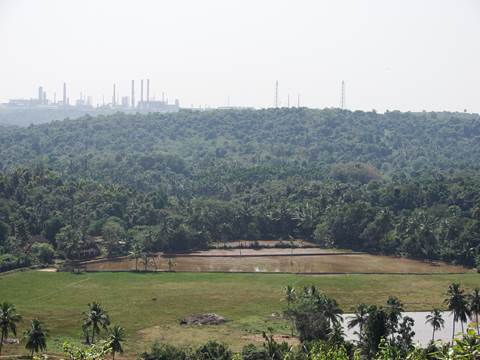 Figure 2. View of diverse landscape in Permude Grama Panchayat.
Figure 2. View of diverse landscape in Permude Grama Panchayat. 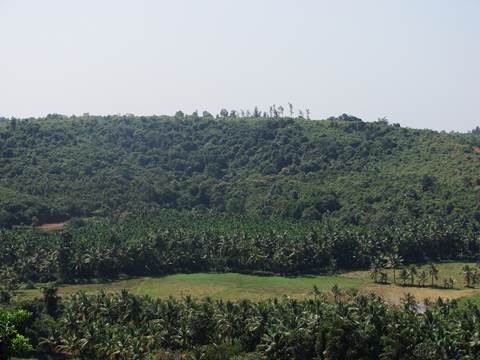 Figure 3. Valley near Tenka Yekkaru, with mixed vegetation.
Figure 3. Valley near Tenka Yekkaru, with mixed vegetation.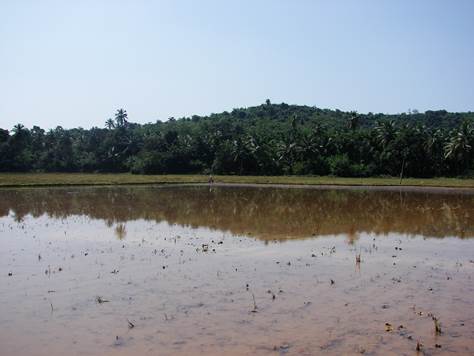
Figure 4. Biologically productive wetlands
Figure 5. Landcover with diverse and lush green vegetation – a repository for biodiversity
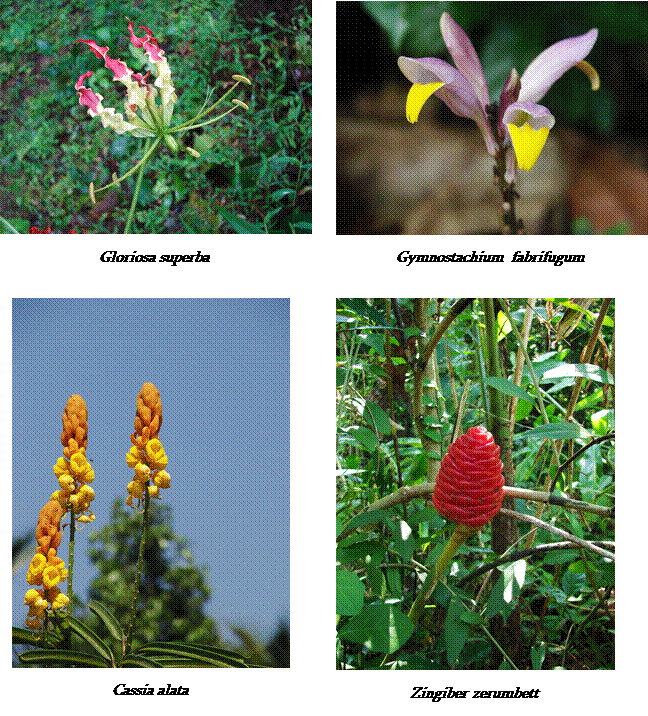
Figure 6. Diversity of flowering plants
Table 4. Butterfly species recorded with their ecological status.
Species |
Common Name |
Ecological Status |
Pachliopta aristolochiae Fabricius |
Common Rose |
|
Pachliopta hector L., |
Crimson Rose |
Endangered |
Graphium sarpedon L., |
Common Bluebottle |
|
Graphium doson C&R Felder |
Common Jay |
|
Graphium agamemnon L., |
Tailed Jay |
|
Papilio demoleus L., |
Lime Butterfly |
|
Papilio dravidarum Wood-Mason |
Malabar Raven |
Endemic* |
Papilio polytes L., |
Common Mormon |
|
Papilio paris L., |
Paris Peacock |
|
Catopsilia pomona Fabricius |
Common Emigrant |
|
Catopsilia pyranthe L., |
Mottled Emigrant |
|
Eurema brigitta Cramer |
Small Grass Yellow |
|
Eurema hecabe L., |
Common Grass Yellow |
|
Delias eucharis Drury |
Common Jezebel |
Schedule I |
Leptosia nina Fabricius |
Psyche |
|
Ixias pyrene L., |
Yellow Orange Tip |
|
Pareronia valeria Cramer |
Common wanderer |
|
Melanitis leda L., |
Common Evening Brown |
|
Elymnias hypermenstra L., |
Common Palmfly |
|
Mycalesis perseus Fabricius |
Common Bushbrown |
|
Orsotrioena medus Fabricius |
The Nigger |
|
Ypthima asterope Klug |
Common Three-ring |
|
Acraea violae Fabricius |
Tawny Coster |
|
Cupha erymanthis Drury |
Rustic |
|
Phalanta phalantha Drury |
Common Leopard |
|
Cirrochroa thais Fabricius |
Tamil Yeoman |
|
Argyreus hyperbius L., |
Indian Fritillary |
|
Neptis hylas Moore |
Common Sailer |
|
Pantoporia hordonia Stoll |
Common Lascar |
|
Ariadne merione Cramer |
Common Castor |
|
Junonia orithya L., |
Blue Pansy |
|
Junonia lemonias L., |
Lemon Pansy |
|
Junonia atlites L., |
Grey Pansy |
|
Junonia iphita Cramer |
Chocolate Pansy |
|
Hypolimnas misippus L., |
Danaid Eggfly |
Endangered, Schedule I |
Kallima horsfieldi Kollar |
South Indian Blue Oak Leaf |
Endemic* |
Tirumala limniace Cramer |
Blue Tiger |
|
Danaus chrysippus L., |
Plain Tiger |
|
Euploea core Cramer |
Common Indian Crow |
|
Castalius rosimon Fabricius |
Common Pierrot |
Schedule I |
Caleta caleta Hewitson |
Angled Pierrot |
|
Everes lacturnus Godart |
Indian Cupid |
|
Neopithecops zalmora Butler |
Quaker |
|
Pseudozizeeria maha Kollar |
Pale Grass Blue |
|
Zizula hylax Fabricius |
Tiny Grass Blue |
|
Chilades laius Stoll |
Lime Blue |
|
Freyeria trochylus Freyer |
Grass Jewel |
|
Lampides boeticus L., |
Pea Blue |
Schedule II |
Jamides celeno Cramer |
Common Cerulean |
|
Talicada nyseus Guerin-Meneville |
Red Pierrot |
|
Rapala manea Hewitson |
Slate Flash |
|
Hasora chromus Cramer |
Common Banded Awl |
|
Hasora badra Moore |
Common Awl |
|
Tagiades litigiosa Moschler |
Water Snow Flat |
|
Sarangesa dasahara Moore |
Common Small Flat |
|
Lambrix salsala Moore |
Chestnut Bob |
|
Taractrocera maevius Fabricius |
Common Gras Dart |
|
Talicota colon Fabricius |
Pale Palm Dart |
|
Borbo cinnara Wallace |
Rice Swift |
|
* Endemic to Western Ghats region
Table 5. Odonates species recorded from selected localities.
Scientific Name |
Common Name |
Pseudagrion microcephalum |
Blue Grass Dartlet |
Ceriagrion cerinorubellum |
Orange tailed Marsh dart |
Brachythemis contaminate |
Ditch Jewel |
Diplocodes trivialis |
Ground Skimmer |
Ictinogomphus rapax |
Common Clubtail |
Neurothemis tullia |
Pied Paddy Skimmer |
Orthetrum Sabina |
Green Marsh Hawk |
Trithemis aurora |
Crimson Marsh Glider |
Rhyothemis variegate |
Common picture wing |
Pantala flavescens |
Wandering glider |
Crocothemis servilia |
Ruddy marsh skimmer |
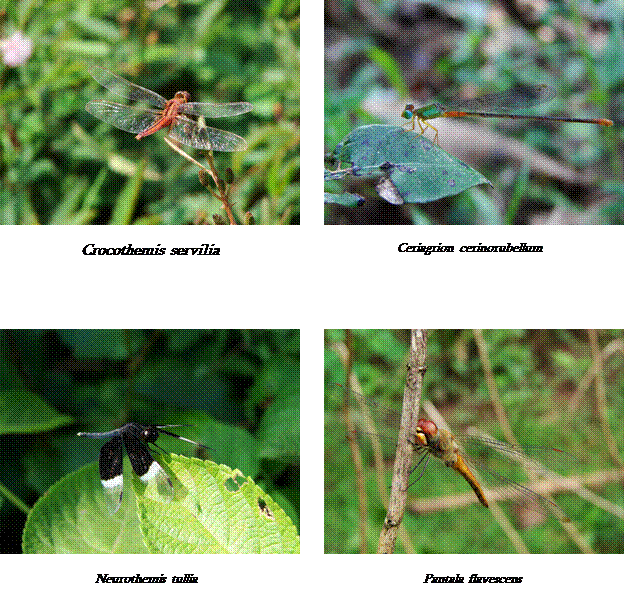
Figure 7. Glimpse of biodiversity - odonate species from the study region
Table 6. Amphibians found in streams and wetlands near Tenka Yekkaru
Species |
Common name |
Status* |
Endemic |
Family: Dicroglossidae. |
|
|
|
Fejervarya sp |
|
|
|
Fejervarya limnocharis |
Cricket frog |
Least concerned |
|
Euphlyctis cyanophlyctis |
Skitter frog |
Least concerned |
|
Hoplobatrachus tigerinus |
Indian bull frog |
Least concerned |
|
Family: Ranidae |
|
|
|
Sylvirana aurantiaca |
Golden frog |
Vulnerable (Schedule IV) |
Western Ghats |
Family: Rhacophoridae |
|
|
|
Philautus wynaadensis |
Wynaad shrub frog |
Endangered |
Western Ghats |
* Ecological status based on Global Amphibian Assessment and IUCN
Table 7. Reptiles observed in the study area.
Common name |
Scientific name |
Skink |
Mobuya carinata |
Checkered Keelback |
Xenochrophis piscatar (Schedule II) |
Lizard sp. |
Calotes sp. |
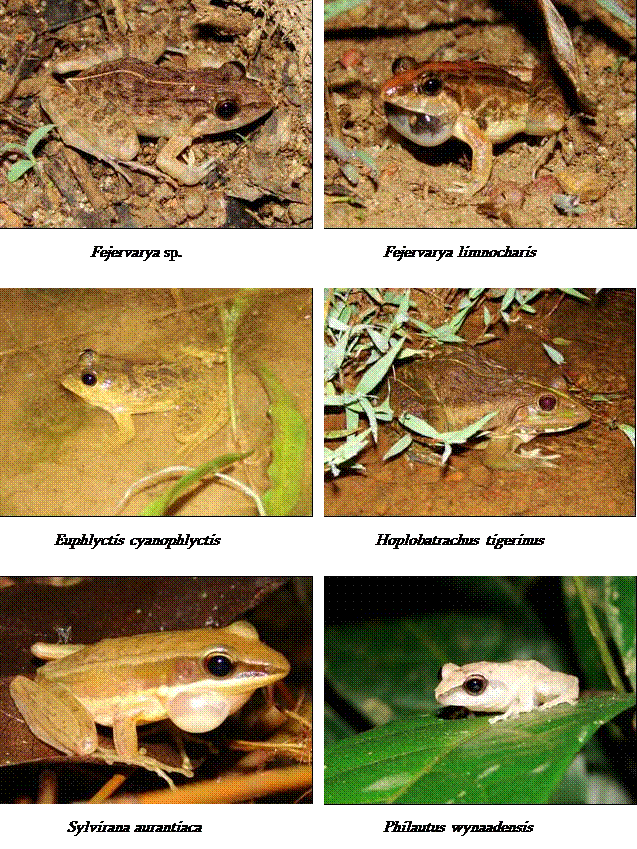
Figure 8. Amphibians recorded from the study region
Table 8. Check list of birds recorded from the region
Common name |
Scientific name |
Ashy wood swallow |
Artamus fuscus |
Black-hooded oriole |
Oriolus xanthornus |
Black-headed munia |
Lonchura Malacca |
Rock pigeon |
Columba livia (Schedule IV) |
Golden-fronted leafbird |
Chloropsis aurifrons |
Common myna |
Acridotheres tristis |
Black drongo |
Dicrurus macrocercus |
Eurasian golden oriole |
Oriolus oriolus |
Brown shrike |
Lanius cristatus |
Greater coucal |
Centropus sinenis |
Grey wagtail |
Motacilla cinerea |
House crow |
Corvus splendens |
Indian robin |
Saxicoloides fulicata |
Jungle babbler |
Turdoides straitus |
Large-billed crow |
Corvus macrorhynchos |
Asian koel |
Eudynamys scolopacea |
Common flameback |
Dinopium javanense |
Little egret |
Egretta garzetta |
Little ringed plover |
Charadrius dubius |
Vernal hanging parrot |
Loriculus vernalis |
Intermediate egret |
Mesophoyx intermedia |
Asian paradise-flycatcher |
Terpsiphone paradise |
Black kite |
Milvus migrans |
White-browed wagtail |
Motacilla maderaspatensis |
Indian pond heron |
Ardeola grayii |
Purple-rumped sunbird |
Nectarinia zeylonica |
Purple sunbird |
Nectarinia asiatica |
Red-whiskered bulbul |
Pycnonotus jocosus |
Red-wattled lapwing |
Vanellus indicus |
Greater Racket-tailed drongo |
Dicrurus paradiseus |
Rose-ringed parakeet |
Psittacula krameri |
Scarlet minivet |
Pericrocotus flammeus |
Common kingfisher |
Alcedo atthis |
White-cheecked barbet |
Megalaima viridis |
Green bee-eater |
Merops orientalis |
Blue-tailed bee-eater |
Merops philippinus |
Spotted dove |
Streptopelia chinensis |
Scaly-breasted munia |
Lonchura punctulata |
Spotted owlet |
Athene brama |
Common tailorbird |
Orthotomus sutorius |
Thick-billed flowerpecker |
Dicaeum agile |
Rufous treepie |
Dendrocitta vegabunda |
White wagtail |
Motacilla alba |
White-throated kingfisher |
Halcyon smyrnesis |
White-breasted waterhen |
Amaurornis phoenicurus |
Wood sandpiper |
Tringa glareola |
Yellow wagtail |
Motacilla flava |
Marsh sandpiper |
Tringa stagnatilis |
Common redshank |
Tringa tetanus |
Baya weaver |
Ploceus philippinsis |
Red spurfowl |
Galloperdix spadicea |
Indian peafowl |
Pavo cristatus (Schedule I) |
Unidentified-leaf warbler |
|
Unidentified-Swallow |
|
Unidentified-Swifts |
|
Table 9. Mammals observed in the region.
Common name |
Scientific name |
WPA* 1972 |
Gaur |
Bos gaurus |
Schedule I |
Wild boar |
Sus scrofa |
Schedule III |
Indian Hare |
Lepus nigricolis |
Schedule IV |
Spotted deer |
Axis axis |
Schedule III |
Porcupine |
Hystrix indica |
Schedule IV |
Common mongoose |
Herpestes sp. |
Schedule II |
Flying squirrel |
Petaurista philippensis |
Schedule II |
* WPA - Wildlife Protection Act
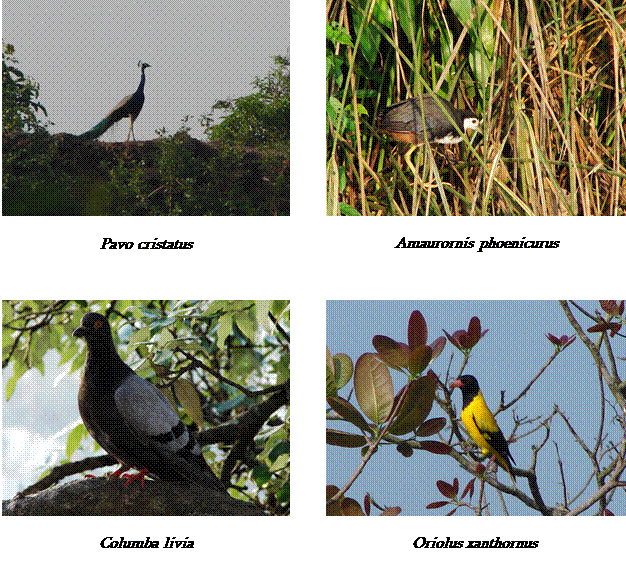
Figure 9. selected bird species from the study region
Dr. T.V. Ramachandra
Centre for Sustainable Technologies,
Centre for infrastructure, Sustainable Transportation and Urban Planning (CiSTUP),
Energy & Wetlands Research Group, Centre for Ecological Sciences, Indian Institute of Science, Bangalore – 560 012, INDIA.
E-mail : cestvr@ces.iisc.ac.in
Tel: 91-080-22933099/23600985,
Fax: 91-080-23601428/23600085
Web: http://ces.iisc.ac.in/energy
Subash Chandran M.D. Energy & Wetlands Research Group, Centre for Ecological Sciences, Indian Institute of Science, Bangalore – 560 012, INDIA.
E-mail:
subhashc@iisc.ac.in
Harish R. BhatEnergy & Wetlands Research Group, Centre for Ecological Sciences, Indian Institute of Science, Bangalore – 560 012, INDIA.
E-mail:
harishrbhat@gmail.com
Vishnu D Mukri
Energy & Wetlands Research Group, Centre for Ecological Sciences, Indian Institute of Science, Bangalore – 560 012, INDIA.
Gururaja K V
Energy & Wetlands Research Group, Centre for Ecological Sciences, Indian Institute of Science, Bangalore – 560 012, INDIA.
Sameer Ali
Energy & Wetlands Research Group, Centre for Ecological Sciences, Indian Institute of Science, Bangalore – 560 012, INDIA.
Karthick B
Energy & Wetlands Research Group, Centre for Ecological Sciences, Indian Institute of Science, Bangalore – 560 012, INDIA.
Citation:Ramachandra T V, Subash Chandran M D, Harish R Bhat, Vishnu D. Mukri, Gururaja KV, Sameer Ali, Karthick B and Boominathan B. 2007. Biodiversity Inventory in and around Tenka Yekkaru Grama Panchayat, Mangalore Taluk, Dakshina Kannada district, Karnataka, ENVIS Technical Report 132, Sahyadri Conservation Series 72, Energy & Wetlands Research Group, CES, Indian Institute of Science, Bangalore 560012
| Contact Address : |
| |
Dr. T.V. Ramachandra
Energy & Wetlands Research Group,
Centre for Ecological Sciences, TE 15, New Biology Building, Third Floor, E Wing, [Near D Gate], Indian Institute of Science, Bangalore – 560 012, INDIA.
Tel : 91-80-22933099 / 22933503-extn 107
Fax : 91-80-23601428 / 23600085 / 23600683 [CES-TVR]
E-mail : cestvr@ces.iisc.ac.in, energy@ces.iisc.ac.in,
Web : http://wgbis.ces.iisc.ac.in/energy |